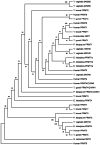Protein arginine methyltransferases in protozoan parasites
- PMID: 35331350
- PMCID: PMC11010539
- DOI: 10.1017/S0031182021002043
Protein arginine methyltransferases in protozoan parasites
Abstract
Arginine methylation is a post-translational modification involved in gene transcription, signalling pathways, DNA repair, RNA metabolism and splicing, among others, mechanisms that in protozoa parasites may be involved in pathogenicity-related events. This modification is performed by protein arginine methyltransferases (PRMTs), which according to their products are divided into three main types: type I yields monomethylarginine (MMA) and asymmetric dimethylarginine; type II produces MMA and symmetric dimethylarginine; whereas type III catalyses MMA only. Nine PRMTs (PRMT1 to PRMT9) have been characterized in humans, whereas in protozoa parasites, except for Giardia intestinalis, three to eight PRMTs have been identified, where in each group there are at least two enzymes belonging to type I, the majority with higher similarity to human PRMT1, and one of type II, related to human PRMT5. However, the information on the role of most of these enzymes in the parasites biology is limited so far. Here, current knowledge of PRMTs in protozoan parasites is reviewed; these enzymes participate in the cell growth, stress response, stage transitions and virulence of these microorganisms. Thus, PRMTs are attractive targets for developing new therapeutic strategies against these pathogens.
Keywords: Arginine methylation; post-translational modification; protein arginine methyltransferases; protozoan parasites.
Conflict of interest statement
The author declares there are no conflicts of interest.
Figures



Similar articles
-
Type I and II PRMTs inversely regulate post-transcriptional intron detention through Sm and CHTOP methylation.Elife. 2022 Jan 5;11:e72867. doi: 10.7554/eLife.72867. Elife. 2022. PMID: 34984976 Free PMC article.
-
Loss of the major Type I arginine methyltransferase PRMT1 causes substrate scavenging by other PRMTs.Sci Rep. 2013;3:1311. doi: 10.1038/srep01311. Sci Rep. 2013. PMID: 23419748 Free PMC article.
-
Unique Features of Human Protein Arginine Methyltransferase 9 (PRMT9) and Its Substrate RNA Splicing Factor SF3B2.J Biol Chem. 2015 Jul 3;290(27):16723-43. doi: 10.1074/jbc.M115.659433. Epub 2015 May 15. J Biol Chem. 2015. PMID: 25979344 Free PMC article.
-
Protein Arginine Methyltransferases in Cardiovascular and Neuronal Function.Mol Neurobiol. 2020 Mar;57(3):1716-1732. doi: 10.1007/s12035-019-01850-z. Epub 2019 Dec 10. Mol Neurobiol. 2020. PMID: 31823198 Free PMC article. Review.
-
PRMT1 in human neoplasm: cancer biology and potential therapeutic target.Cell Commun Signal. 2024 Feb 8;22(1):102. doi: 10.1186/s12964-024-01506-z. Cell Commun Signal. 2024. PMID: 38326807 Free PMC article. Review.
Cited by
-
PRMT5 Inhibitor EPZ015666 Decreases the Viability and Encystment of Entamoeba invadens.Molecules. 2024 Dec 27;30(1):62. doi: 10.3390/molecules30010062. Molecules. 2024. PMID: 39795118 Free PMC article.
-
Chemical probes and methods for the study of protein arginine methylation.RSC Chem Biol. 2023 Jul 28;4(9):647-669. doi: 10.1039/d3cb00018d. eCollection 2023 Aug 30. RSC Chem Biol. 2023. PMID: 37654509 Free PMC article. Review.
References
-
- Alcoforado Diniz J, Chaves MM, Vaselek S, Miserani Magalhães RD, Ricci-Azevedo R, de Carvalho RVH, Lorenzon LB, Ferreira TR, Zamboni D, Walrad PB, Volf P, Sacks DL and Cruz AK (2021) Protein methyltransferase 7 deficiency in Leishmania major increases neutrophil associated pathology in murine model. PLoS Neglected Tropical Diseases 15, e0009230. - PMC - PubMed
Publication types
MeSH terms
Substances
LinkOut - more resources
Full Text Sources

